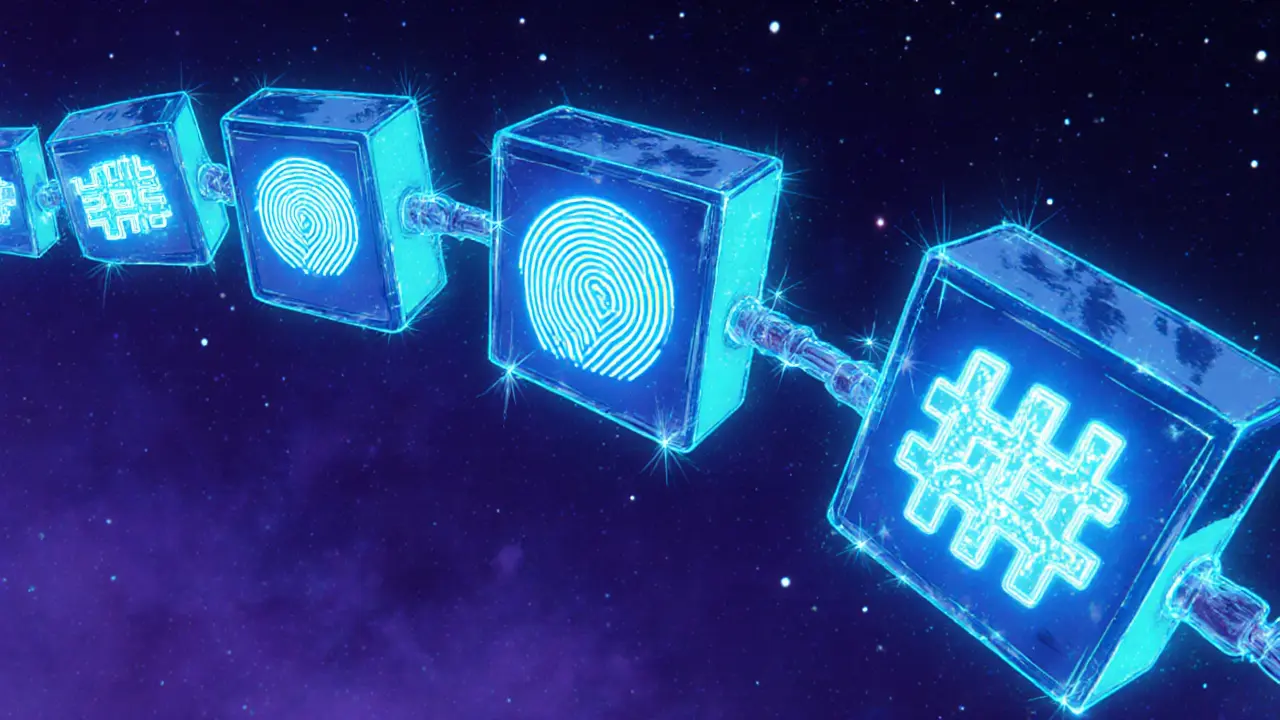Blockchain Immutability Explorer
Cryptographic Hashing
Every block contains a hash of its contents and the previous block. Even a tiny change creates a completely different hash.
Merkle Tree
Each block uses a Merkle tree to efficiently verify transactions without storing all data.
Blockchain Chain Visualization
See how blocks link together and how changing one affects the entire chain.
Hash: ABC123
Hash: DEF456
Hash: GHI789
Hash: JKL012
Consensus Mechanisms
Different methods ensure network-wide agreement on block validity.
Immutability Impact
Understanding the trade-offs of blockchain immutability.
- Advantages: Tamper-proof records, audit trails
- Disadvantages: Privacy concerns, inability to delete data
- Trade-offs: Energy consumption vs. security
Quick Takeaways
- Each block’s hash links it to the previous block, so any change breaks the chain.
- Proof of Work (PoW) and Proof of Stake (PoS) force attackers to control the majority of the network.
- Merkle trees let a single transaction be verified without exposing the whole block.
- Immutable ledgers provide tamper‑proof audit trails for finance, supply chain, healthcare, and more.
- Future consensus designs aim to keep immutability while cutting energy use.
When you read about a "tamper‑proof" ledger, the first thing that comes to mind is blockchain immutability. In plain terms, once data lands on a blockchain it can’t be altered, deleted, or forged. This article breaks down the exact technical tricks that make that promise real - from cryptographic hashes to the economics of consensus. By the end you’ll know why changing a single record is practically impossible and what trade‑offs each consensus model brings.
Cryptographic Hashing: The Digital Fingerprint
Cryptographic hash is a one‑way function that converts any input into a fixed‑size string of characters. The hash changes dramatically if even a single bit of the input is tweaked, which makes it perfect for detecting tampering. In a blockchain, every block’s hash is computed from the block’s transaction data, a timestamp, and the hash of the previous block. If an attacker tries to rewrite a past transaction, the hash for that block changes, which instantly invalidates the linking hash in the next block and so on down the chain.
Because hashes are deterministic, every node can recompute them and verify the chain’s integrity without trusting a central authority. The most common algorithms today are SHA‑256 (used by Bitcoin) and Keccak‑256 (used by Ethereum). Their collision resistance means two different inputs will never produce the same output, reinforcing the “no‑go‑back” property.
Chain Structure and Merkle Trees
Beyond the simple hash‑link, blockchains use Merkle tree is a binary tree where each leaf node holds a transaction hash and each parent node holds the hash of its two children. This structure allows a single transaction to be proven as part of a block by presenting a short path of hashes, called a Merkle proof.
Merkle trees keep block sizes small and verification fast. A block that contains thousands of transactions can still be validated by checking only a handful of hashes. If any transaction is altered, its leaf hash changes, cascading up the tree and breaking the block’s root hash - the value stored in the block header. This adds another layer of immutability: tampering with an individual transaction is just as easy to spot as changing an entire block.

Timestamps: Ordering the Ledger
Each block also carries a timestamp is the exact moment a block is created, recorded in Unix time format. Timestamps enforce chronological order, ensuring that newer blocks always sit on top of older ones. If an attacker tried to insert a forged block with an earlier timestamp, the network’s consensus rules would reject it because it wouldn’t align with the longest‑valid chain.
Combined with hash linking, timestamps make retroactive changes detectable and economically unviable. The ledger becomes a time‑ordered, verifiable sequence that no participant can reorder without the agreement of the entire network.
Consensus Mechanisms: The Economic Guardrails
Hashing and chaining protect the data structure, but consensus protocols defend the network against coordinated attacks. Two dominant models are Proof of Work (PoW) and Proof of Stake (PoS).
Proof of Work is a consensus algorithm where miners solve computational puzzles to propose new blocks. The puzzle’s difficulty adjusts so that, on average, a new block appears every fixed interval (e.g., 10 minutes for Bitcoin). To rewrite history, an attacker would need to redo the work for the targeted block and every subsequent block, then outrun the combined hashing power of honest miners - a feat that becomes astronomically expensive as the chain grows.
Proof of Stake is a consensus algorithm where validators lock up cryptocurrency as collateral and are chosen to propose blocks based on stake and other factors. Instead of raw computing power, the security comes from the economic risk of losing the staked assets if a validator tries to cheat. An attacker would need to acquire a majority of the total stake, which is typically far more costly than amassing hash power.
| Attribute | Proof of Work | Proof of Stake |
|---|---|---|
| Energy Consumption | High - relies on intensive calculations | Low - selection is algorithmic, not computational |
| Security Model | Hash power majority needed to attack | Stake majority needed to attack |
| Finality | Probabilistic - more confirmations = higher confidence | Deterministic - block considered final once validated |
| Hardware Requirements | Specialized ASICs or GPUs | Standard servers suffice |
Both models require network‑wide agreement before a block is added. Changing a past block would force an attacker to redo the consensus work for every following block and still win the majority vote - an endeavor that grows exponentially harder the longer the chain becomes.
Decentralized Nodes: Distributed Trust
The blockchain network consists of many node is a participant computer that stores a copy of the ledger and validates new blocks. Nodes independently verify hashes, Merkle roots, timestamps, and consensus criteria before they accept a new block. This redundancy means there’s no single point of failure; even if a handful of nodes go offline, the rest keep the ledger alive and immutable.
Because each node holds the full history, any attempt to rewrite a block must be propagated to every node and accepted by the consensus algorithm. The cost of coordinating such a rewrite across a global, heterogeneous network is what makes blockchain immutability practically irreversible.

Why Immutability Matters: Real‑World Benefits and Limits
Immutable ledgers provide a built‑in audit trail. Financial institutions can prove that a transaction never changed after settlement, regulators can trace asset flows, and supply‑chain managers can verify provenance without relying on a third‑party auditor.
However, the same permanence can be a double‑edged sword. Once data is recorded, it cannot be removed, which raises privacy concerns (e.g., GDPR “right to be forgotten”). Governance mechanisms, such as on‑chain voting or protocol upgrades, must be carefully designed because any change requires broad consensus - a process that can be slow and contentious.
Energy consumption is another practical limit, especially for PoW chains. The massive electricity use has spurred a shift toward PoS and hybrid models that preserve security while cutting the environmental footprint.
Implementation Considerations for Developers
If you’re building a blockchain or integrating one into an enterprise system, start with the core primitives:
- Choose a hashing algorithm (SHA‑256 for Bitcoin‑style, Keccak‑256 for Ethereum‑style).
- Design the block header to include the previous hash, Merkle root, timestamp, and a nonce or stake‑related field.
- Implement a Merkle tree library to create and verify proofs efficiently.
- Select a consensus protocol that matches your security‑vs‑efficiency trade‑off.
- Set up a peer‑to‑peer networking layer so nodes can broadcast and validate blocks.
Testing on a private network helps you fine‑tune parameters like block time, difficulty adjustment, and stake slashing conditions. Remember that real‑world immutability only holds when the network is sufficiently decentralized; a small testnet can be reverted easily, so the security guarantees emerge only at scale.
Future Directions: Keeping Immutability Sustainable
Researchers are exploring alternatives such as delegated Proof of Stake is a variant where token holders elect a small set of validators to produce blocks, and hybrid models that combine PoW for initial bootstrapping with PoS for ongoing operation. These aim to retain the strong immutability guarantees while reducing energy use and improving transaction throughput.
Layer‑2 solutions (e.g., rollups) also preserve immutability by anchoring compressed transaction data onto the base chain’s immutable ledger, offering scalability without sacrificing security.
In short, the core ideas-hash linking, Merkle trees, timestamps, consensus, and decentralization-will stay the backbone of immutable ledgers. What will evolve is how efficiently we can achieve those guarantees at the scale the world demands.
Frequently Asked Questions
Can a blockchain ever be altered?
Technically a block can be changed, but doing so requires recomputing every subsequent block’s hash and winning consensus for each new block. The computational or economic cost grows exponentially, making successful tampering virtually impossible on a well‑distributed network.
Why are hashes so important for immutability?
A hash turns any amount of data into a fixed‑size fingerprint. If the data changes, the hash changes. By storing each block’s hash within the next block, any alteration breaks the chain, and nodes can instantly spot the mismatch.
What’s the main difference between PoW and PoS regarding immutability?
PoW relies on raw computing power; an attacker must own >50% of the network’s hash rate. PoS relies on economic stake; an attacker must control >50% of the token supply. Both make rewriting history prohibitively expensive, but PoS does it with far less energy consumption.
How do Merkle trees help with immutability?
Merkle trees allow a single transaction’s integrity to be proven with a short hash path. If any transaction changes, its leaf hash and all parent hashes change, breaking the block’s Merkle root stored in the header, which is then caught by the network.
Is immutability a problem for privacy regulations?
Yes, because data cannot be deleted once written. Some projects use off‑chain storage for personal data and only keep cryptographic hashes on‑chain, allowing the actual information to be removed while still preserving the immutable proof.








Promise Usoh
June 26, 2025 AT 21:03In the realm of blockchain, the hash of each block serves as a cryptographic anchor, binding the current block to its predecessor. When a single bit changes, the resulting hash diverges completely, making any tampering evident to every node in the network. This property, combined with the chained structure, creates a fortress of data integrity that is extremely hard to breach without consensus.
Katherine Sparks
June 26, 2025 AT 22:26Great overview of immutability! 😊
Shaian Rawlins
June 26, 2025 AT 23:50The article really breaks down each piece of the puzzle in a way that anyone can follow. First, the hash function acts like a fingerprint for the block, and any alteration shatters that fingerprint. Then, the Merkle tree lets you verify individual transactions without exposing everything. The timestamps give a chronological order that prevents a rogue block from slipping in. On top of that, consensus mechanisms-whether PoW or PoS-add economic weight to the security. All these layers stack together, making the ledger practically immutable once it reaches a certain depth.
Miranda Co
June 27, 2025 AT 01:13If you think PoW is just a waste of electricity, you're missing the point-this is how security is earned!
Eva Lee
June 27, 2025 AT 02:36Beyond the classic hash-link, modern designs incorporate DAG structures and sharding to boost throughput while preserving the immutable core. The jargon-heavy components like state roots and validity proofs add another defense layer, ensuring that each shard still respects the global consensus.
Patrick MANCLIÈRE
June 27, 2025 AT 04:00For anyone building a blockchain, start by implementing a solid Merkle tree library. It lets you generate compact proofs that any node can verify without pulling the whole block. Pair that with a well‑defined block header-previous hash, Merkle root, timestamp, and a nonce or stake field-and you’ve got the backbone of immutability.
Ciaran Byrne
June 27, 2025 AT 05:23Exactly, the proof is just a few hashes.
Greer Pitts
June 27, 2025 AT 06:46Loved the interactive demo! It really shows how a single change ripples through the whole chain.
Lurline Wiese
June 27, 2025 AT 08:10Wow, this article blew my mind!!!
Adarsh Menon
June 27, 2025 AT 09:33Oh sure, just change a block and the universe will correct itself.
Tyrone Tubero
June 27, 2025 AT 10:56Behold, the cryptographic artistry that makes tampering feel like trying to rewrite history with a feather.
Rob Watts
June 27, 2025 AT 12:20Hashes link blocks, nodes verify, consensus finalizes.
Bhagwat Sen
June 27, 2025 AT 13:43By the way, have you considered layer‑2 solutions to keep the base chain lean while still preserving immutability?
Cathy Ruff
June 27, 2025 AT 15:06Your take on privacy is clueless; you ignore the real regulatory pressures.
mukesh chy
June 27, 2025 AT 16:30Because energy consumption is the only metric that matters, right?
Scott McReynolds
June 27, 2025 AT 17:53Immutability isn’t just a buzzword; it’s the foundation that lets blockchains earn trust. When a block’s hash is calculated from its contents and the previous hash, the entire chain becomes interlocked. Any tiny alteration in a transaction forces the block’s hash to change, which instantly invalidates the next block’s reference. This cascade means an attacker must redo every subsequent block to stay consistent. In Proof‑of‑Work systems, that also means solving a new cryptographic puzzle for each forged block, which quickly becomes computationally infeasible. Proof‑of‑Stake replaces raw computing power with economic stake, but the principle stays: you must control a majority of the network’s resources to rewrite history. Nodes across the globe independently verify each new block, so a rogue attempt is broadcast and rejected unless it meets consensus rules. The Merkle tree adds another safeguard: a single transaction’s integrity can be proven with a short hash path, and any tampering breaks the root hash stored in the header. Timestamps enforce chronological order, preventing an attacker from slipping an older block into the chain. Together, these mechanisms create a system where the cost of alteration grows exponentially as the chain matures. That cost is what gives blockchains their “tamper‑proof” reputation. It also means that real‑world deployments must consider the trade‑off between permanence and privacy. The longer a chain, the harder it is to reverse, which is both a strength and a regulatory challenge. Nonetheless, the layered design-hash linking, Merkle roots, timestamps, consensus, and decentralised verification-ensures that once data lands on a well‑distributed ledger, it stays there virtually forever.
John Corey Turner
June 27, 2025 AT 19:16Indeed, the tapestry of security woven by these components makes the ledger resilient against any single point of failure.
Kimberly Kempken
June 27, 2025 AT 20:40No, PoS is just a fad that will crumble under real‑world attacks.
stephanie lauman
June 27, 2025 AT 22:03The security arguments presented are fundamentally flawed. 😒
Brooklyn O'Neill
June 27, 2025 AT 23:26Great job, everyone-remember to test on a private net before going public.
Jenise Williams-Green
June 28, 2025 AT 00:50This is why we must protect data integrity at all costs!
Laurie Kathiari
June 28, 2025 AT 02:13Nice summary, looking forward to more insights.